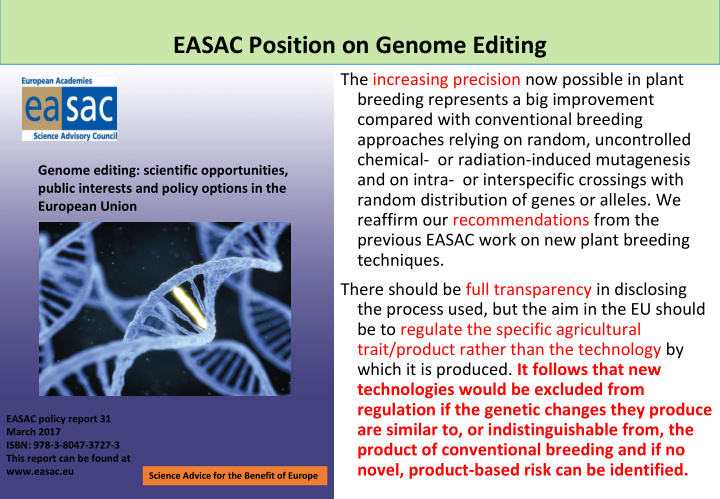



EASAC Position on Genome Editing The increasing precision now possible in plant breeding represents a big improvement compared with conventional breeding approaches relying on random, uncontrolled chemical- or radiation-induced mutagenesis Genome editing: scientific opportunities, and on intra- or interspecific crossings with public interests and policy options in the random distribution of genes or alleles. We European Union reaffirm our recommendations from the previous EASAC work on new plant breeding techniques. There should be full transparency in disclosing the process used, but the aim in the EU should be to regulate the specific agricultural trait/product rather than the technology by which it is produced. It follows that new technologies would be excluded from regulation if the genetic changes they produce EASAC policy report 31 are similar to, or indistinguishable from, the March 2017 ISBN: 978-3-8047-3727-3 product of conventional breeding and if no This report can be found at novel, product-based risk can be identified. www.easac.eu Science Advice for the Benefit of Europe
EASAC Position on Latest Breeding Methods July 2015 • EU policy development for agricultural innovation should be transparent, proportionate and fully informed by the advancing scientific evidence and experience worldwide. • It is timely to resolve current legislative uncertainties. • The aim in the EU should be to regulate the specific agricultural trait and/or product, not the technology. • Modernising EU regulatory frameworks would help to address the implications of current policy disconnects in support of science and innovation at regional and global levels. At the same time, there is also continuing need for wide-ranging engagement on critical issues and this should include re-examination of the appropriate use of the precautionary principle.
The SAM/HLG Explanatory Note: Safety ➢ Assessment of safety can only realistically be made on a case-by-case basis and depends on features of the end product ➢ Genetically and phenotypically similar products deriving from the use of different techniques are not expected to present significantly different risks Conclusion (not expressed in the Note): Establishing additional safety measures for those plants would contradict the well-established legal principle for products having a “history of safe use”.
Off-targets: the context matters SAM/HLG Explanatory Note This precision and control over changes made is greater than with the use of conventional breeding or established techniques of genetic modification. As a consequence, these new techniques result in fewer unintended effects. Where does the focus on Off-targets come from? What are the consequences? Which level of uncertainty are we accepting for centuries? Is that a biosafety issue? Research questions ▪ Improved designs and assessments to limit off-target editing ▪ Understanding the downstream meaning of off-target edits We should discuss the issue of off-target editing always in the context with conventional breeding including mutation breeding !!!
To be, or not to be a GMO, that is the question 3 categories: • No GMO • GMO, but exempted • GMO Source: http://www.thecultureclub.net/wp-content/uploads/2010/10/tennant_ham let.jpg
To be, or not to be a GMO, … We should not forget: Beyond the EU regulations on GMO there are other regulations in place that prevent consumers and the environment from exposure to hazardous products. This framework proved to be sufficient with regard to conventional breeding techniques including mutagenesis. Therefore, the case-by-case statement does neither request nor promote the necessity of a regulatory overhaul. ▪ Protocols for DUS ( Distinctness, Uniformity and Stability) and VCU (Value for Cultivation and Use) testing ▪ Common catalogue of varieties of agricultural plant species and marketing of vegetable seed 2002/53-57 ▪ Plant Health Regulation (EU) 2016/2031 ▪ Seed Treatment Regulation (EC) No 1107/2009 ▪ General Environmental Liability 2004/35/CE
To be, or not to be a GMO, … 3,500 new varieties are authorized for marketing within the European Union each year. Plant varieties developed through the latest breeding methods should not be subject to different or additional regulations if they could also have been produced through ➢ earlier breeding methods or ➢ by natural processes without human intervention.
European Court of Justice - preliminary ruling OPINION OF ADVOCATE GENERAL BOBEK delivered on 18 January 2018 Case C ‑ 528/16
European Court of Justice - preliminary ruling First reaction On the Advocate General’s Opinion regarding mutagenesis and the Genetically Modified Organisms Directive The European Plant Science Organisation welcomes the Advocate General’s opinion in case C-528/16 published today (18 Jan 2018) as an important step in clarifying the European Directive 2001/18/EC concerning organisms modified by recent mutagenesis techniques that appeared after 2001. The opinion provides a general scheme to follow now by the European Court of Justice.
Principles for Regulatory Requirements: No GMO The genetic variation in the final plant product should not be covered under the scope of the existing GMO regulation if ➢ the genetic variation is the result of spontaneous or induced mutagenesis or ➢ there is no novel combination of genetic material (i.e. no stable insertion in the plant genome of one ore more genes that are part of a designed genetic construct) and ➢ the final plant product solely contains the stable insertion of inherited genetic material from sexually compatible plant species.
Looking over the edge of the plate … Genome editing is challenging our views and interpretation of the current regulatory systems - worldwide
I have a dream … “I have a dream that one day my plants could live in a nation where they will not be judged by the way they were born but by the content of their characters.”
Recommend
More recommend